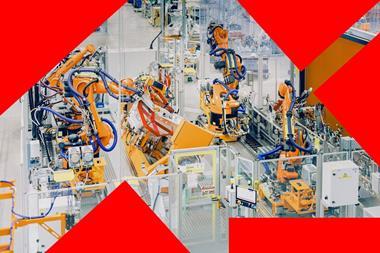
Widespread digitalisation within automotive manufacturing is providing the opportunity for seating and interiors suppliers to move up the value chain
 With the Fourth Industrial Revolution well underway, automotive suppliers need to assess their Industry 4.0 readiness across all operations. The car of the future will be highly connected, electric and autonomous. New business models will emerge from this brave new digital world with, on the one hand, a new breed of “digital native” consumers driving demand for increasingly more personalised services and, on the other hand, the OEMs, who will seek out partners in the supplier ecosystem with the right expertise to help them capitalise on nascent opportunities.
With the Fourth Industrial Revolution well underway, automotive suppliers need to assess their Industry 4.0 readiness across all operations. The car of the future will be highly connected, electric and autonomous. New business models will emerge from this brave new digital world with, on the one hand, a new breed of “digital native” consumers driving demand for increasingly more personalised services and, on the other hand, the OEMs, who will seek out partners in the supplier ecosystem with the right expertise to help them capitalise on nascent opportunities.
Customisation right inside the factoryMass customisation of vehicle interiors is an ongoing consumer trend that is becoming increasingly reliant on virtual reality simulation. “The link between the customerand the factory is getting shorter and shorter,” observes Norbert Audéoud, operational excellence and strategic transformation expert. “Now the customer can go inside your factory, because new technologies enable him to customise vehicle models and enjoy a first experience of his new car through virtual reality.”
While virtual showrooms and augmented reality are enabling carmakers to meet consumer expectations in novel and engaging ways, this implies an even more complex business environment for automotive interior suppliers to manage.
“This will transform the supply chain for good because this is going to shake up the interiors industry,” notes Benny Daniel, VP Consulting – Mobility EIA, Frost & Sullivan. “At the moment, if you look at the interiors industry, it’s a very transactional kind of relationship, where you have a hierarchical approach between the OEMs, tier ones and tier twos. As soon as the ecosystem becomes digitised and highly automated, you will see more value-added services.”
Digitally enabled manufacturing processesIndeed, the digitalisation of processes – from concept to finished product – offers the most direct path to fulfilling these increasingly complex consumer expectations. To derive the most value from the opportunities that Industry 4.0 manufacturing promises, suppliers will have to first incorporate digitalisation into their manufacturing roadmap.
“Widespread digitalisation provides the opportunity for the value chain players to enter new territories,” adds Daniel.
“For example, we have seen, and these trends are very visible, tier two players who were previously just consulted for cutting activities, are now moving up the value chain, moving more into value-added service like cutting and sewing, design, and also setting up their own seat plant infrastructure. In today’s automotive world, they provide the options to the OEMs, in terms of design, number of patterns complexity and creating new needs in the OEMs. This itself drives efficiency programmes within the OEMs.”
"When the customer is dictating the change, it is important for the supplier structures – from tier ones to tier twos – to provide the solution" - Benny Daniels, Frost & Sullivan
Early opportunities for Industry 4.0-ready suppliersThe automotive industry was among the first to resort to automation and innovative manufacturing technologies. Widespread adoption of Industry 4.0 standards will accelerate this movement and help auto suppliers overcome their specific challenges, such as connecting data and information from different sources throughout the entire supply chain. Indeed, their greatest challenge is gaining the visibility to streamline and monitor all processes across all operations. Industry 4.0 technologies provide this much-needed visibility by achieving smooth workflow through a high level of integration both horizontally (connecting machines, production sites) and vertically (connecting the top floor to the shop floor).
This same visibility will guide the OEMs in their choices as they decide on with whom they work as vehicles become more personalised. “At the moment, the majority of the OEMs’ focus has been on cost optimisation,” states Daniel. “Now, with the advent of connected, autonomous, and shared mobility, individual personalisation becomes important because the driver for change is the customer himself. So, when the customer is dictating the change, it is important for the supplier structures, from tier ones to tier twos, to be prepared in order to provide the solution. So OEMs will likely have a greater say, not just in how they shape the tier one but also the tier two structure. Digitalisation is here to stay, and the supply chain does not respond accordingly, they’ll lose the opportunity.”

From concept to finished product, digitalisation offers the direct path to fulfilling complex consumer expectations
As the first to adopt Industry 4.0 standards, the OEMs will most likely be among the most demanding organisations in terms of factory automation, leading to a reorganisation of the supplier ecosystem by degree of maturity. “The automotive industry is among the leaders in 4.0 strategy but there is a big gap between the major players and the tier twos and tier threes,” says Audéoud. “There, we have a huge difference in maturity, but we need to take into account that most companies have undertaken efforts, only 16% have a true strategy at scale. Normally, companies should have 30% of profit coming from digitalisation and that’s not the case today.”
Transforming cutting room processesNew applications of software and analytics are producing novel approaches to the improvement of industrial asset operations. The integration of cloud-based analytics with industrial machinery offers a tremendous opportunity for productivity gains. Technologies can be leveraged to drill down into data for insight into asset performance and all related processes, enabling substantial increases in productivity and efficiency. Industry 4.0 capitalises on these evolutions in automation and connectivity to offer a decentralised production model at plant level, from the design stage through to supply chain interaction, manufacturing, distribution and customer service.
Inside the automotive cutting room, Industry 4.0-enabled processes will allow vehicle seating and interiors suppliers to achieve material savings and control production costs while improving both operational performance and manufacturing processes. With growing demand for increasingly more personalised interiors, managing the complexity of production processes is a key benefit of technologically enabled manufacturing processes.
“This itself drives efficiency programmes within the OEMs,” points out Daniel. “If you look at the traditional industry today, each vehicle programme requires their own set of investments, in terms of presses, moulds and dies. As soon as we see this industry move toward digitalisation, you will see a much more software-oriented kind of focus where the investments are no longer in presses and in moulds, but rather in software, where you can have customisation for a wider, more diverse array of projects for OEMs.”
Business disruption that creates valueInnovative new technologies are helping the entire automotive interiors supplier ecosystem to re-think the way it works. Networked embedded systems and automation, the
development of new software products, and the delivery of new services like analytics-driven services will transform the way supply chain players interact. More business insight will be derived from data and shared as connectivity and automation are increasingly deployed. Sophisticated new forms of multilayer decision support will help to guide both business strategy and operations management. New revenue streams will also be created by capitalising on business insight derived from the mass collection of data.
“The new technologies require a change of mind-set regarding the relationship we’ve built with customers,” summarises Audéoud. “There is a new intimacy that should be developed because on one hand, you will have more information about your customers and the entire supply chain, and on the other hand, the expectation of an exciting customer experience will be greater every day. With the data you’re getting from customers, you’ll be able to have a better design, a better production and better service.”









































